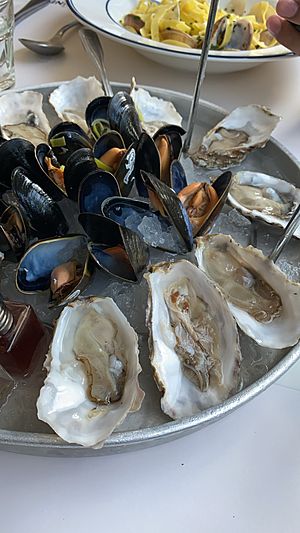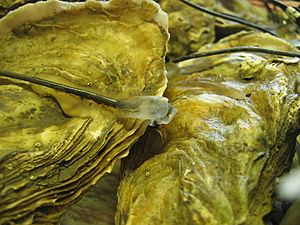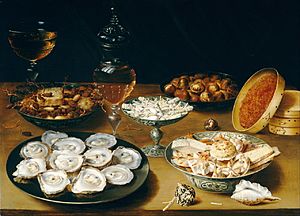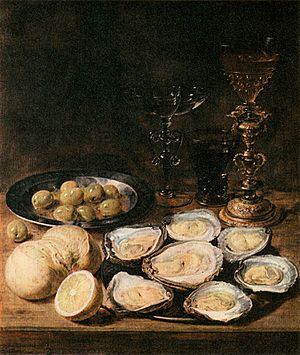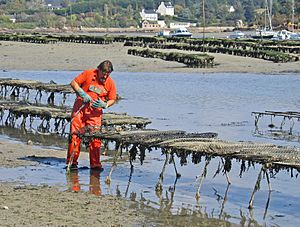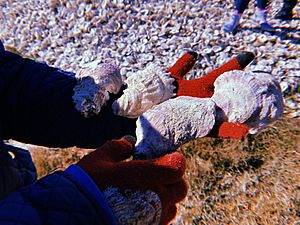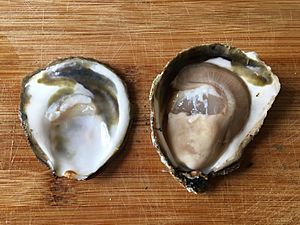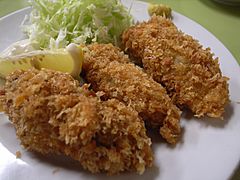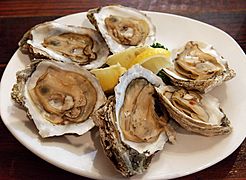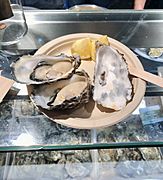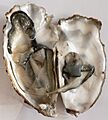Oyster facts for kids
Quick facts for kids Oyster |
|
|---|---|
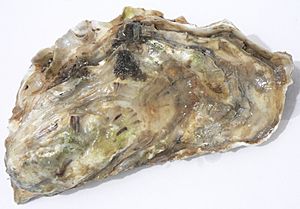 |
|
| Pacific oyster from the Marennes-Oléron basin in France | |
| Scientific classification | |
| Kingdom: | Animalia |
| Phylum: | Mollusca |
| Class: | Bivalvia |
| Subclass: | Pteriomorphia |
| Groups included | |
|
|
| Cladistically included but traditionally excluded taxa | |
|
All other members of:
|
|
An oyster is a type of mollusc that lives in salty or slightly salty water. They are a kind of bivalve, meaning they have two shells. Oysters often have rough, uneven shells. Many kinds of oysters belong to a group called Ostreoidea.
People often eat oysters, either cooked or raw, and they are seen as a special food. Some types of pearl oysters are grown to get the pearls they make inside their shells. Other oysters, like the clear Windowpane oysters, are valued for their beautiful shells.
Contents
What is an Oyster?
Where the Name "Oyster" Comes From
The word "oyster" came into English in the 1300s. It comes from an old French word, oistre. This French word came from the Latin word ostrea, which means 'oyster'. The Latin word itself came from the Ancient Greek word ostreon.
Different Kinds of Oysters
There are several types of oysters, each with unique features.
True Oysters
True oysters are part of the Ostreidae family. This group includes the oysters that people eat most often. Some common types are the European flat oyster, eastern oyster, Olympia oyster, Pacific oyster, and the Sydney rock oyster. These oysters first appeared a very long time ago, during the Early Triassic period.
Pearl Oysters
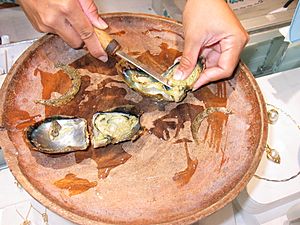
Most molluscs with shells can make pearls, but not all pearls are valuable. Pearls can grow in both salty and fresh water.
Pearl oysters are not closely related to true oysters. They belong to a different family called feathered oysters (Pteriidae). Both cultured pearls (grown by people) and natural pearls can come from pearl oysters. Other molluscs, like freshwater mussels, also produce valuable pearls.
The biggest pearl-making oyster is the Pinctada maxima, which can be as large as a dinner plate. Not every oyster naturally produces a pearl.
In nature, pearl oysters make pearls by covering a tiny object that gets inside their shell with many layers of a shiny material called nacre. Over time, this builds up into a pearl. The color and shape of the pearl depend on the nacre's natural color and the shape of the original object.
Pearl farmers can create pearls by putting a small bead, usually made of polished mussel shell, inside the oyster. After three to seven years, the oyster can produce a perfect pearl. Today, most pearls sold are cultured pearls, not natural ones.
Other Oyster Types
Many other bivalve molluscs are called "oysters" because they taste or look similar to true oysters. Some even make pearls. Examples include:
- Thorny oysters (from the Spondylus group)
- Pilgrim oyster (another name for a scallop)
- Saddle oysters (also called jingle shells)
- Dimydarian oysters
- Windowpane oysters
In the Philippines, a local thorny oyster called Tikod amo is a popular and expensive seafood.
Oyster Body Parts
Oysters mostly breathe using their gills. They also exchange gases through their mantles, which have many tiny blood vessels. A small, three-chambered heart pumps clear blood throughout their body. Two kidneys help remove waste from the blood. Oysters have a simple nervous system but no brain.
How Oysters Reproduce
Some oysters have both male and female reproductive parts. This means they can fertilize their own eggs.
When a female oyster releases millions of fertilized eggs into the water, they develop into tiny larvae in about six hours. These larvae float in the water for two to three weeks. Then, they settle down on a surface, like another oyster shell, and grow into adult oysters within a year.
How Oysters Eat
Oysters are filter feeders. They pull water over their gills using tiny hairs called cilia. Small plankton and other particles get stuck in the mucus on their gills. These particles are then moved to the oyster's mouth, eaten, and digested. Waste is released as small pellets that sink to the bottom.
Oysters eat best when the water temperature is between 68 and 78 degrees Fahrenheit (20-25°C). A single oyster can filter up to 50 gallons (190 liters) of water per day. This means oyster populations can greatly improve water quality. For example, the Chesapeake Bay's oysters used to filter all the water in the bay in just a few days.
Where Oysters Live
A group of oysters is called a bed or an oyster reef. These reefs are very important because they provide a home for many other sea creatures.
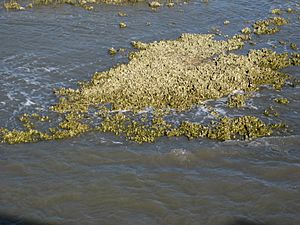
Some oysters, like Crassostrea and Saccostrea, live in the intertidal zone, which is the area covered and uncovered by tides. Others, like Ostrea, live underwater all the time. The hard shells and nooks of oyster reefs create places for hundreds of small animals to live. These include sea anemones, barnacles, and hooked mussels. Many of these small animals become food for larger fish like striped bass and black drum.
An oyster reef can make a flat seafloor 50 times more complex. An oyster's shape depends on where it attaches, but it always faces its flared shell upward. One shell is cupped, and the other is flat.
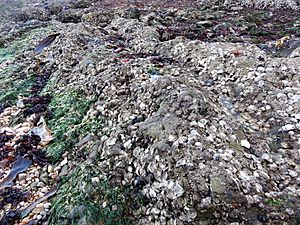
Oysters usually become adults in one year. They often start as males, releasing sperm into the water. As they grow older and have more energy, they become females and release eggs. A single female oyster can produce up to 100 million eggs each year. The eggs are fertilized in the water and develop into larvae. These larvae then find a place to settle, often on another oyster's shell. Young oysters that have settled are called spat.
Oysters filter water to eat and breathe, but they don't stay open all the time. They regularly close their shells to rest, even underwater. Their behavior changes with the tides and the sun. They close for longer periods during neap tides (when tides are weakest) than during spring tides (when tides are strongest).
Some tropical oysters, like the mangrove oyster, grow on mangrove roots. They are easy to collect when the tide is low.
The Chesapeake Bay in the United States used to be the largest oyster-producing area, but overfishing and pollution have reduced its oyster beds. Willapa Bay in Washington now produces the most oysters in the US. Other big oyster farming areas are along the Gulf of Mexico coast. In 2005, China produced 80% of the world's oysters, and France was a leader in Europe.
Common predators of oysters include crabs, seabirds, starfish, and humans.
Oysters and the Environment
Oysters are excellent at filtering water. They remove tiny plants (plankton) and other particles from the water. Studies show that oysters can filter a lot of water each day, making the water cleaner and clearer. They remove harmful substances like nitrogen and phosphorus, which helps keep the water healthy.
Oyster reefs are also seen as a natural way to protect shorelines. They help reduce waves and provide homes for many different kinds of sea life. Because of their importance, many efforts are being made to restore oyster reefs around the world.
Oysters in History
Ancient piles of oyster shells, called middens, show that people have eaten oysters for thousands of years. Oysters were grown in Japan as early as 2000 BC. In the United Kingdom, the town of Whitstable has been farming oysters since Roman times. The town of Colchester even has an annual Oyster Feast. In Victorian England, people often ate oysters with beer. Some breweries even started adding crushed oyster shells to their beer, creating the first oyster stout.
The French town of Cancale is famous for its oysters, also dating back to Roman times. A Roman merchant named Sergius Orata was known for his clever ways of growing oysters using channels and locks to control the tides.
In the early 1800s, oysters were cheap and mostly eaten by working-class people. New York Harbor became the world's largest source of oysters. Millions of oysters were harvested there every day. However, too much harvesting and pollution destroyed most of the oyster beds by the early 1900s. This made oysters scarce and more expensive, turning them into a luxury food.
In Britain, the native European flat oyster takes five years to grow and is protected during its spawning season. Today, larger Pacific oyster and Rock oyster species are farmed year-round.
Getting Oysters from the Wild
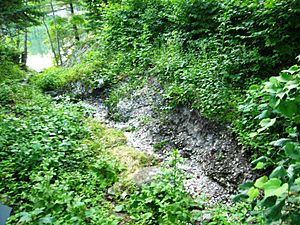
Oysters are collected from their beds in different ways. In shallow water, people can gather them by hand or with small rakes. In deeper water, long-handled rakes or special oyster tongs are used. Some boats use a scallop dredge, which is a toothed bar with a net bag, to scoop up oysters. However, dredging can harm the oyster beds, so it is often restricted.
Oysters can also be collected by divers. After collection, oysters are sorted to remove dead ones or unwanted items. Then, they are sold fresh or canned.
Farming Oysters
Oysters have been farmed for thousands of years. The Pacific oyster (Magallana gigas) is the most widely farmed bivalve worldwide today. Two common farming methods are used:
- Release: Young oysters, called spat, are spread over existing oyster beds. They grow naturally and are harvested like wild oysters.
- Bagging: Spat are placed in special racks or bags that keep them above the seafloor. This protects them from some predators. When they are grown, the bags are simply lifted to collect the oysters. This method is more expensive but safer for the oysters.
Sometimes, sterile oysters are grown to prevent them from spreading into unwanted areas. These oysters cannot reproduce.
Bringing Oysters Back (Restoration)
In many places, non-native oysters have been introduced to try and help failing native oyster populations. For example, the eastern oyster was brought to California in 1875, and the Pacific oyster in 1929. However, introducing new species can be controversial.
In the Chesapeake Bay, efforts are being made to restore the native Eastern oyster population. Researchers are building artificial reefs using waste oyster shells to help young oysters grow. They are also using oysters that are resistant to diseases.
The "oyster-tecture" movement uses oyster reefs to clean water and protect coastlines from waves. These projects help filter water and increase sea life.
How Humans Affect Oysters
Introducing new species can harm native oyster populations. For example, non-native oysters have caused a big loss of California's Olympia oysters.
Noise pollution underwater can also affect oysters. They close their shells when exposed to loud, low-frequency sounds. Oysters use sounds from waves and currents to know when to open and close, and even when to spawn. Noise from cargo ships or construction can disturb them.
Climate change also affects oysters around the world, impacting their growth and behavior.
Oysters as Food
Someone once said, "He was a bold man that first ate an oyster!" But people have been eating oysters for a very long time, as shown by ancient shell piles found worldwide. Oyster fishing used to be a huge industry. Overfishing, diseases, and pollution have greatly reduced oyster supplies, but they are still a popular food celebrated at many festivals.
It was once believed that oysters were only safe to eat in months with the letter 'r' in their name (September to April). This is partly true because oysters are more likely to spoil in warmer months (May, June, July, August). Also, certain bacteria that can make people sick are more common in oysters from warm waters during summer.
Oyster Dishes
Oysters can be eaten in many ways: raw on the half shell, smoked, boiled, baked, fried, roasted, stewed, canned, pickled, steamed, or broiled. Eating them raw can be as simple as opening the shell and slurping the contents with their juice. People often add butter and salt. Fancy dishes like Oysters Rockefeller are more complex.
-
Raw "Fine de Claire" oysters served at Mercado de San Miguel in Madrid.
When eating raw oysters, you can add lemon juice, vinegar, or cocktail sauce. Some restaurants serve them with a special sauce called mignonette. Raw oysters have many different flavors depending on where they come from: salty, buttery, metallic, or fruity. Their texture is soft but also a bit crisp. The taste of oysters changes based on the water's saltiness, minerals, and nutrients.
What's in an Oyster?
Oysters are a great source of important nutrients like zinc, iron, calcium, and selenium. They also contain vitamin A and vitamin B12. Oysters are low in calories; a dozen raw oysters has only about 110 calories. They are rich in protein. Just two oysters can provide all the zinc and vitamin B12 you need for a day!
Opening Oysters (Shucking)
Opening oysters, called "shucking," takes skill. You need a special oyster knife with a short, thick blade.
Here's a common way to shuck an oyster:
- Push the knife blade into the hinge where the two shells meet. You might need to wiggle it a bit.
- Twist the blade until you hear a small pop.
- Slide the blade upward to cut the muscle that holds the shell closed.
It's easy to slip and get hurt, so wearing thick gloves is a good idea. Professional shuckers can open an oyster in less than three seconds!
Oyster shucking has even become a competitive sport around the world.
Keeping Oysters Safe to Eat
Unlike most seafood, fresh oysters can last up to four weeks, but they taste best when fresh. Oysters must be alive right before you eat or cook them.
If a cooked oyster doesn't open, it's usually a sign it was dead before cooking and should not be eaten. To check if a raw oyster is alive, tap its shell. A live oyster will close tightly. If it stays open and doesn't respond, it's dead and should be thrown away.
Oysters can sometimes contain harmful bacteria. Since oysters filter water, they can collect anything in the water around them. For example, oysters from the Gulf Coast can have high levels of bacteria in warm months, which can make people sick, especially those with weak immune systems.
Cleaning Oysters (Depuration)
Depuration is a process used in the oyster industry to make oysters safer to eat. Since oysters are often eaten raw, many countries require this cleaning process.
After oysters are harvested, they are placed in tanks with clean, sterilized water for 48 to 72 hours. During this time, the oysters filter the clean water and remove any harmful bacteria or waste from their bodies. This process helps make the oysters safe for people to eat.
Oyster Diseases
Oysters can get various diseases that can harm their populations. Scientists are working to understand and control these diseases.
- Dermo is caused by a tiny parasite. It can cause many oysters to die and is a big problem for the oyster industry. It does not harm humans who eat infected oysters.
- MSX is another disease caused by a parasite. It causes many deaths in the eastern oyster, but some oysters can become resistant.
- Denman Island disease causes yellow or green spots on oysters. This disease mainly affects Pacific oysters.
Some oysters can also carry bacteria that can make humans sick, like Vibrio vulnificus. This can cause stomach problems or serious skin infections, especially if the oyster's contents get into a cut on the skin.
Images for kids
See also
 In Spanish: Ostrea para niños
In Spanish: Ostrea para niños


